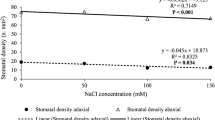Abstract
Acclimated and non-acclimated potted plants of Sanguinaria canadensis L. were harvested at early and late dormancy, anthesis, and immature and mature fruiting stages. Sanguinarine content and concentration were determined for rhizomes (distal, proximal, and middle sections), roots, leaves, flower, and fruit. Rhizomes had highest sanguinarine content and concentrations, and exhibited decreasing concentration gradients from the distal to proximal third. Concentrations in roots were a tenth of rhizome concentration. Concentrations in leaves, flowers, and fruit were one-thousandth of rhizome Sanguinarine content in whole acclimated plants was constant. Content in whole nonacclimated plants increased as the plant became physiologically active, but was constant during fruit maturation: content in roots, leaves, and fruit did not change. The substantial increase in whole-plant dry weight coupled with the unchanging sanguinarine content during fruit maturation suggests either a shift in photosynthate allocation from defense to growth, or a constant turnover of sanguinarine.
Similar content being viewed by others
Literature Cited
Bennett, B. C., C. R. Bell, and R. T. Boulware. 1990. Geographic-variation in alkaloid content of Sanguinaria canadensis (Papaveraceae). Rhodora 92(870):57–69.
Bird, D. A., V. R. Franceschi, and P. J. Facchini. 2003. A tale of three cell types: Alkaloid biosynthesis is localized to sieve elements in opium poppy. The Plant Cell 15:2626–2635.
Daddona, P. E., J. L. Wright, and C. R. Hutchinson. 1976. Alkaloid catabolism and mobilization in Catharanthus roseus. Phytochemistry 15(6): 941–945.
Defel, N. E. 1980. Alkaloid distribution and catabolism in Cephalotaxus harringtonia. Phytochemistry 19(3):403–408.
Fairbairn, J. W., and S. Elmasry. 1968. Alkaloids of Papaver somniferum L.6. Bound morphine and seed development. Phytochemistry 7(2):181–187.
Godowski, K. C.. 1989. Antimicrobial action of sanguinarine. Journal of Clinical Dentistry 1:91–101.
Gulmon, S. L., and H. A. Mooney. 1986. Costs of defense and their effect on plant productivity. Pages 681–698 in Thomas J. Givnish, ed. On the economy of plant form and function. Proceedings of the Sixth Maria Moors Cabot Symposium, “Evolutionary Constraints of Primary Productivity: Adaptive Patterns of Energy Capture in Plants,” Harvard Forest, August 1983. Cambridge University Press, Cambridge, England.
Jeng, J. H., H. L. Wu, B. R. Lin, W. H. Lan, H. H. Chang, Y. S. Ho, P. H. Lee, Y. J. Wang, J. S. Wang, Y. J. Chen, and M. C. Chang. 2006. Antiplatelet effect of sanguinarine is correlated to calcium mobilization, thromboxane and cAMP production. Atherosclerosis (E-publication ahead of print).
Kopsell, D. E., D. A. Kopsell, W. M. Randle, T. W. Coolong, C. E. Sams, and J. Curran-Celentano. 2003. Kale carotenoids remain stable while flavor compounds respond to changes in sulfur fertility. Journal of Agriculatural and Food Chemistry 51:5319–5325.
Lopus, M., and D. Panda. 2006. The benzophenanthridine alkaloid sanguinarine perturbs microtubule assembly dynamics through tubulin binding. A possible mechanism for its antiproliferative activity. FEBS Journal 273(10):2136–2150.
Mahady, G. B., S. L. Penland, A. Stoia, and L. R. Chadwick. 2003. In vitro susceptibility of Helicobacter pylori to isoquinoline alkaloids from Sanguinaria canadensis and Hydrastis canadensis. Phytotherapy Research 17:217–221.
—, C. W. Beecher, and A. B. Schilling. 1993. Sanguinaria candensis. L. (Sanguinaria): In vitro culture and the production of benzophenanthridine alkaloids. Pages 313–328 in Y. P. S. Bajaj, ed. Biotechnology in agriculture and forestry. Vol 24. Springer-Verlag, Berlin.
Mascarenhas, A. K., C. M. Allen, and M. L. Moeschberger. 2002. The association between Viadent use and oral leukoplakia—Results of a matched case-control study. Journal of Public Health Dentistry 62(3):158–162.
Persons, W. Scott, and Jeanine M. Davis. 2005. Growing and marketing ginseng, goldenseal and other woodland medicinals. Bright Mountain Books, Inc., Fairview, North Carolina.
Ralphs, M. H., and D. R. Gardner. 2003. Distribution of norditerpene alkaloids in tall larkspur plant parts through the growing season. Journal of Chemical Ecology 29(9):2013–2021.
—, D. R. Gardner, and J. A. Pfister. 2000. A functional explanation for patterns of norditerpenoid alkaloid levels in tall larkspur (Delphinium barbeyi). Journal of Chemical Ecology 26(7):1595–1607.
Reinhart, P., R. Harkrader, R. Wylie, G. Yewey, and K. C. Vanhorne. 1991. Sanguinarine levels in biological samples by high-performance liquidchromatography. Journal of Chromatography-Biomedical Applications 570(2):425–434.
Salmore, A. K., and M. D. Hunter. 2001. Elevational trends in defense chemistry, vegetation, and reproduction in Sanguinaria canadensis. Journal of Chemical Ecology 27(9):1713–1727,
Small, E., and P. M. Catling. 1999. Canadian medicinal crops. NRC Research Press. Ottawa, Canada.
Vogt, A., A. Tamewitz, J. Skoko, R. P. Sikorski, K. A. Giuliano, and J. S. Lazo. 2005. The benzo[c]phenanthridine alkaloid, sanguinarine, is a selective, cellactive inhibitor of mitogen-activated protein kinase phosphatase-1. The Journal of Biological Chemistry 280(19):19078–19086.
Weid, M., J. Zeigler, and T. M. Kutchan. 2004. The roles of latex and the vascular bundle in morphine biosynthesis in the opium poppy, Papaver sominiferum. Proceedings of the National Academy of Sciences U.S.A. 101(38):13957–13962.
Weiner, M. A., and J. A. Weiner. 1994. Herbs that heal: Prescription for herbal healing. J. Weiner, translator. Quantum Books, Mill Valley, California.
Wold, J. K. 1978. Bound morphine and codeine in capsule of Papaver somniferum. Phytochemistry 17(4):832–833.
Author information
Authors and Affiliations
Corresponding author
Rights and permissions
About this article
Cite this article
Campbell, S., Affolter, J. & Randle, W. Spatial and temporal distribution of the alkaloid sanguinarine in Sanguinaria canadensis L. (Bloodroot). Econ Bot 61, 223–234 (2007). https://doi.org/10.1663/0013-0001(2007)61[223:SATDOT]2.0.CO;2
Received:
Accepted:
Issue Date:
DOI: https://doi.org/10.1663/0013-0001(2007)61[223:SATDOT]2.0.CO;2




